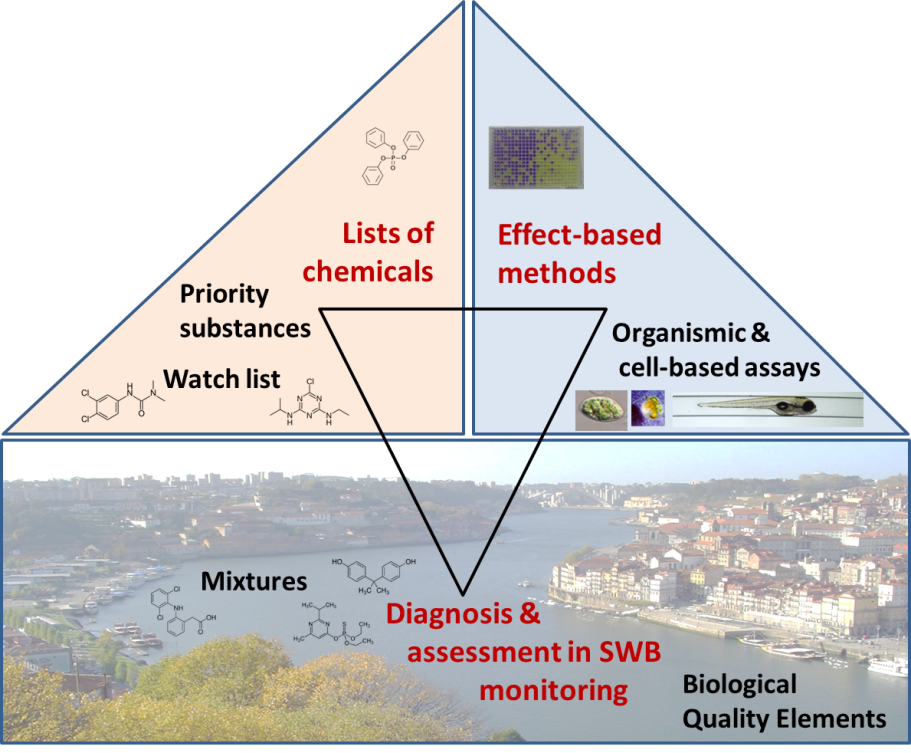Post a comment on the text below
2.7. Challenges
The implementation of effect-based methods into monitoring routines or diagnostic screening approaches would require agreement on the bioassays to be used. Robust bioassays have been developed for some organisms (such as invertebrates like Daphnia) and assays for the detection of estrogenic compounds, with detailed recommendations for application in monitoring (e.g. Kunz et al. 2017).
Broadening the use of analytical techniques to better link chemical and ecological status assessment under the WFD is summarized in figure 2.12.
Figure 2.12: Smart combination of existing approaches for characterizing a water body can support the understanding of connections between chemical contamination and ecological status

Clearly, there are limitations as to what can be reasonably expected from such efforts, with both scientific and practical considerations, such as:
Chemical analysis of freshwaters is limited to what has been looked for, be that through targeted, screening or untargeted analytical strategies. The limitations are specific for each approach;
Complementary use of effect-based methods needs to consider which tests should be used;
Effect-based methods rely on concentrating the dissolved substances in a water sample through solid phase extraction methods. Such methods work well for some organic compounds (non-polar) but not for others (e.g. polar compounds including glyphosate and AMPA) (Reemtsma et al. 2016). Neither metals nor contaminants bound to particles will be detected by the effect-based methods discussed and would thus need separate analysis. This is a significant omission given the relatively widespread failure of metal EQSs (EEA, 2018a; Johnson et al. 2017).
You cannot post comments to this consultation because you are not authenticated. Please log in.



Previous comments
DE-NW:
' Clearly, there are limitations as to what can be reasonably expected from such efforts, with both scientific and practical considerations, such as:'
Standardization and further development of additional bioassays is required since reliable specific bioassays are still missing for several mode of actions.
DE-NW:
'iii) Effect based Methods rely on concentrating the dissolved substances in a water sample through solid phase extraction methods. Such methods work well for some organic compounds (non-polar) but not for others (e.g. polar compounds including glyphosate and AMPA) (Reemtsma et al. 2016). Neither metals nor contaminants bound to particles will be detected by the effect-based methods discussed and would thus need separate analysis. This is a significant omission given the relatively widespread failure of metal EQSs (EEA, 2018a; Johnson et al. 2017).'
Moreover, relevance of sample preparation and concentration steps and what the biotests detect has to be demonstrated. E.g. are the effects detected in a concentrated sample relevant for organisms in the environment or is it drawing a disorted picture of the real conditions in the water phase. Field studies under different conditions are highly needed.
DE-UBA IV 2.2:
Please consider, chemicals below the limit of quantification will also not be detected. However, there are chemicals which show effects below the limit of quantification.
Eurometaux
"Neither metals nor contaminants bound to particles will be detected by the effect-based methods discussed and would thus need separate analysis. This is a significant omission given the relatively widespread failure of metal EQSs"
Indeed, metals may not be detected by the effect-based methods. This is posed here as a problem, but it is not necessarily. We suggest the text also notes that: “Most metals are well-known, can be ccurately measured, and have extensive ecotoxicity data available that allow for the derivation of a reliable EQS. Therefore, traditional substance-based monitoring for metals is well-established, and the need for effects-based methods is less pressing than for other substances which may be unknown, difficult to measure, and/or have highly uncertain EQS”.
P25-26 Applications of EBMs – this is the key area.
Broad spectrum EBMs (i.e. ones that respond to a wide range of chemical moas) don’t do much more than the BQEs do already so I can’t see much point in using them. They might be more sensitive than BQEs but if you can’t see a response in the BQEs why does it matter anyway (unless we want to act on the basis of risk rather than impact)?
On the other hand, very narrow EBMs (ones that respond to only certain moas) may help in diagnosing what was responsible the biological effects seen (as demonstrated by BQEs). These could help address the mixture issue (i.e. they reduce the risk of false negatives) but we have to be clear about what would trigger the use of such EBMs. Would we use diagnostic EBMs at (a) all WBs (i.e. deploy them everywhere on all occasions) or (b) where there is a demonstrable impact as shown in BQEs? This seems a more sensible approach, i.e. where you know you’ve got a problem and you’re trying to diagnose what is responsible.
How do we respond to positive responses in a EBM? Should it be a trigger for (a) remediation (that seems awfully drastic), (b) reporting ‘less than good’ status (that also seems a bit drastic) or (c) more monitoring (that seems sensible, and the EBM would point you toward the chemicals most likely to be of concern). i.e. USE EBMs AS AN INVESTIGATIVE TOOL TO IDENTIFY REASONS FOR POOR STATUS AND TO GUIDE CHEMICAL MONITORING. DO NOT USE EBMS FOR CLASSIFICATION OR DRIVING REMEDIATION.